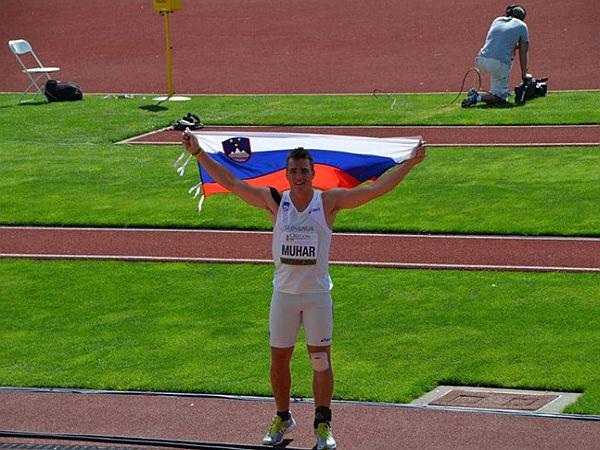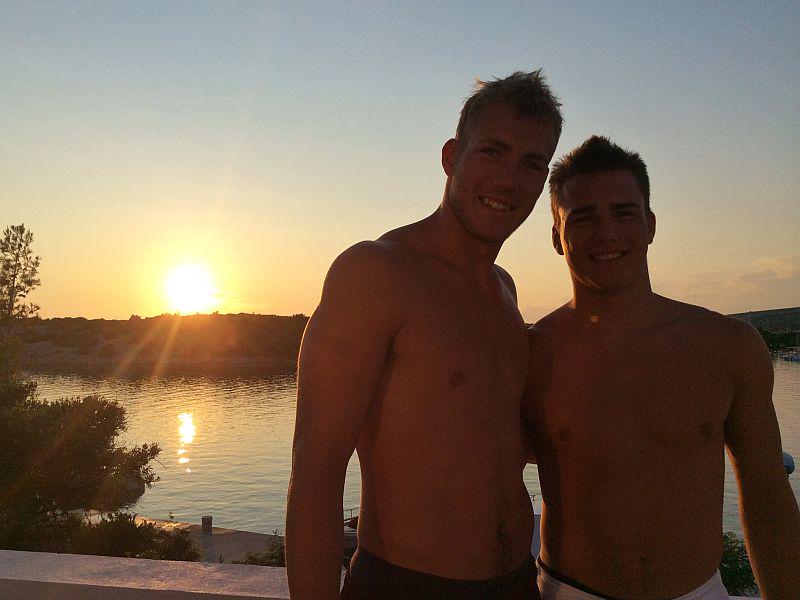





This 18-year-old native of Jesenice, interviewed as part of our Successful Slovenia project, became the junior world vice-champion javelin thrower at the end of July at a meeting in Oregon. That was his second big success, after last year's world championship title in the youth competition. And as top-class javelin throwers fully ripen after the age of 25, Muhar still has time to become part of the world elite. The path he has taken is definitely the right one. For the time being coach Jože Satler will still be the one making sure that young Muhar continues to develop. After that a lot will depend on how he practices in the U.S.
At the end of July in Oregon you became world vice-champion. You surely must be more than satisfied with you career so far?
Two top results in two years are a good stimulus for the continuation of my career. With results like than I can really say that I am satisfied.
Two medals from two big events also prove that you know how to focus when it matters the most. Is it difficult to compose yourself and be fully concentrated?
It's hard to compose yourself at big competitions. Apart from the normal stage fright, nervousness is also present. Normally I start becoming nervous a couple of days before a big event. However during a competition I'm able to think only about performing the most optimal throw.
Keshorn Walcott from Trinidad became an Olympic champion in London in 2012 at the age of 19. At the last European Championships in Helsinki Valerij Jordan from Russia won silver at the age of 20. It is probably more an exception than a rule for such young throwers to be winning medals.
When does a javelin thrower fully ripen, what are the best years for achieving top results?
In my opinion those athletes are more of the exception. Top level javelin throwers ripen between the ages of 25 and 30. For example Pitkamäki, Torkiltsen and Vesely have been among the best throwers for years now.
When do you think you can start competing with the elite, let's say in the Diamond League?
It all depends on my progress. Next year I'll still be a junior and then a youth for three more years. I will still have a lot to learn during those years.
You practice under coach Jože Satler. Are you satisfied with his work?
Joža is my first coach and he knows me from the very beginning. Our cooperation is at a truly high level. He always knows what's good for me.
Do you think that javelin throwers from other countries have better conditions for training?
The conditions may be better regarding the material – javelins, fitness equipment, gyms, throwing grounds… Regarding coaches, I think we're equal. Martina Ratej's coach, Andrej Hajnšek, is also a top level coach.
Do javelin throwers sometimes feel neglected?
Sometimes we do. What bothers me the most is that we're not allowed to throw javelins at the main stadium in Kranj. The green is intended only for football players. We can only throw on the auxiliary throwing ground, where the surface is too hard and we keep breaking our javelins.
How many javelins do you need per season?
Javelins aren't supposed to break that often, except if you throw on hard surfaces like in Kranj. There are more javelin throwers in our club. We need around five javelins for every person. That would be optimal. However we only have around six javelins all together, although there's five of us.
How much does one javelin cost? What kind do you use?
A good javelin, to be used for competition, starts at one thousand euros and higher. Javelins used for practice, which are of lower quality, are cheaper. I personally like using the Nemeth javelins, made in Hungary. Apart from those I also throw Nordic and Polannik javelins.
Javelin throwing is a very technical discipline. What are the specifics when you practice throwing? A good thrower has to be explosive and powerful, but he must not forget the technique and his feeling for the throw. During the winter a lot of work is done in fitness rooms and gyms. In the summer we're outside on the throwing ground.
How did you begin practicing throwing javelins? You are from Jesenice, have you ever tried ice hockey?
I've never practiced ice hockey but I did play it as a hobby. My older brother Jaka introduced me to athletics, as I always followed him around. First I practiced running and jumping, then I started throwing, first it was a ball, then the vortex, the shot put, the discus and then I was ready for the javelin. Until last year I also competed in the multiathlon every year.
Will you also follow you brother Jaka's footsteps regarding education?
He is studying in the U.S. This year I have to finish high school and after that I'll decide what’s best for my future. My wish is to follow Jaka in the U.S., but first I'll have to do my English matura test.
Will you be able to combine school and a career in athletics?
So far I've managed. Regarding the future – let's wait and see. From Jaka's experience I know that in the U.S. it's all taken care of really well. That is why my goal is to get there and get a full scholarship. Do you cooperate with the Slovenian record holder Matija Kranjc? Do you sometimes practice together? There is no close cooperation between us but we do get along well. In the future it wouldn't be a bad idea to practice together from time to time. Just for the motivation.
The European Athletics Championhip kicks off in Zurich on Tuesday. What kind of chances does Matija Kranjc have? Could he make it to the final?
Matija did have good throws this season, and with throws like than he could make it to the final. He's been waiting for a result over 80 meters for a long time now. A result like that could send him to the top. Of course, I'll keep my fingers crossed that he makes it.
Vitezslav Vesely from the Czech Republic will be defending the title. Where does his biggest threat come from? Maybe from Thomas Röhler? Tero Pitkamäki?
Vesely threw really far this year, but I'm betting on Pitkamäki. He has had the most constant form this season.
Which other athletic disciplines do you like to follow, and just can't afford to miss the finals?
When I start watching athletics, I don't leave out any discipline. The queen of sports should be watched as a whole.

































































